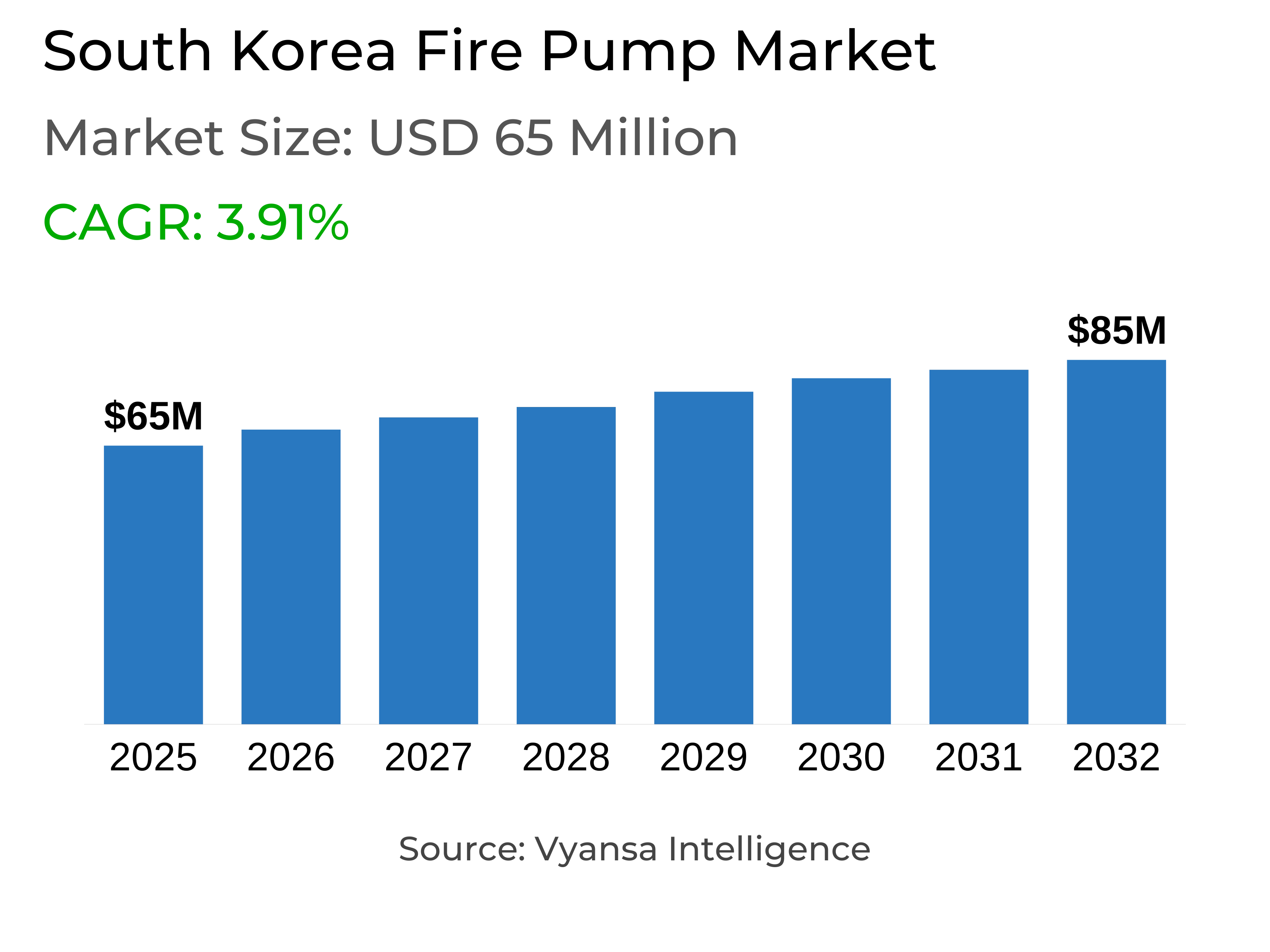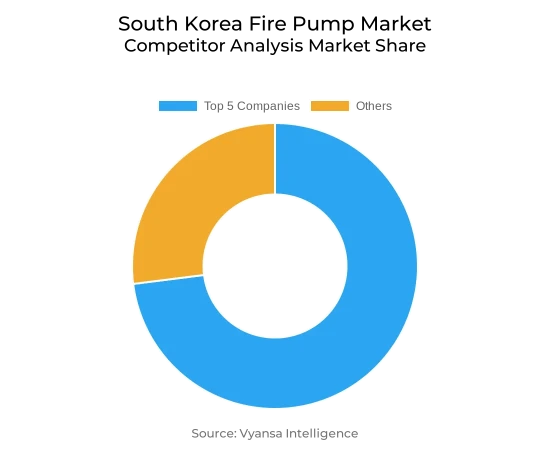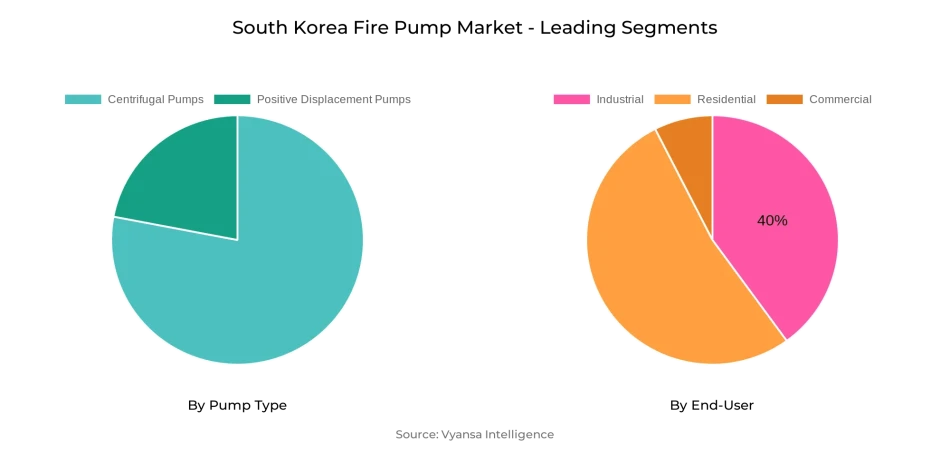
South Korea Fire Pump Market Report: Trends, Growth and Forecast (2026-2032)
By Pump Type (Centrifugal Pumps (Overhung Pumps, Vertical Inline, Horizontal End Suction), Split Case Pumps (Single/Two Stage, Multi Stage)), Positive Displacement Pumps (Diaphragm Pumps, Piston Pumps), By Mode of Operation (Diesel Fire Pump, Electric Fire Pump, Others), By End-User (Residential, Commercial, Industrial)
- Energy & Power
- Oct 2025
- VI0509
- 110
-




South Korea Fire Pump Market Statistics and Insights, 2026
- Market Size Statistics
- Fire Pump in South Korea is estimated at $ 65 Million.
- The market size is expected to grow to $ 85 Million by 2032.
- Market to register a CAGR of around 3.91% during 2026-32.
- Pump Type Segment
- Centrifugal Pumps continues to dominate the market.
- Competition
- More than 10 companies are actively engaged in producing Fire Pump in South Korea.
- Top 5 companies acquired the maximum share of the market.
- WILO SE, Ebara Corporation, ITT Goulds Pumps, Flowserve Corporation, Pentair PLC etc., are few of the top companies.
- End-User
- Industrial grabbed 40% of the market.
South Korea Fire Pump Market Outlook
The South Korea fire pump market, which was worth USD 65 million in 2025, is expected to grow to USD 85 million by 2032 at a CAGR of approximately 3.91% between 2026–32. Adoption in the market is mainly fueled by stringent regulations imposed by the Ministry of Interior and Safety and the Korea Fire Protection Association, which require adherence to more than 85 safety standards. The 2022 Serious Accidents Punishment Act has further heightened accountability, compelling organizations to prioritize certified fire protection systems to avoid legal penalties and reputational risks.
In spite of regulatory enforcement, there are systemic issues because South Korea's accident rates are high. South Korea had 136,796 occupational accidents in 2023 and the construction industry alone had more than 32,000 cases. Small businesses, which frequently lack resources, cannot embrace sophisticated fire protection solutions, creating barriers to the mass upgrade of fire pumps. Nevertheless, broad-scale projects and toughened compliance are compelling industrial and commercial structures to enhance their fire protection infrastructure.
Technology adoption is yet another important driver of growth. IoT-enabled monitoring, predictive maintenance powered by AI, and BIM-based system design are transforming installations on smart city and green construction projects. Programmes such as the Smart City Korea programme and the 3rd Basic Plan for Green Buildings are harmonizing sustainability objectives with fire protection regulations, opening up prospects for energy-saving pump technologies in both newbuilds and retrofits.
From a product viewpoint, centrifugal pumps are at the forefront of the market because they are affordable, reliable, and compatible with smart building systems. At the demand side, industrial end-users are the largest at 40% due to demand for safeguarding high-value assets in manufacturing, petrochemicals, and energy industries. Meanwhile, the commercial segment is the fastest-growing end-user, fueled by urbanization and increasing smart building uptake. Collectively, these forces place the South Korea fire pump market in the midst of steady growth through 2032.

South Korea Fire Pump Market Growth Driver
Regulatory Stringency Accelerates Market Adoption
Fire pump demand in South Korea is increasing as regulatory frameworks become stronger. The Ministry of Interior and Safety has increased fire safety compliance inspections by 30% over the last five years, while the Korea Fire Protection Association mandates over 85 standards, such as technical requirements for pump units. These systems form a solid foundation for standardized installation and maintenance, guaranteeing dependable system performance in various applications. Companies are forced to make proactive investments in certified pumps based on compliance standards.
The passage of the Serious Accidents Punishment Act in 2022 raised the bar on accountability by making criminal liability enforceable against business executives for on-the-job deaths. With the construction sector alone logging 32,353 job-related accidents in 2023, industries are increasingly feeling pressure to secure operations. To avoid risks of legal consequences and brand damage, industrial and commercial buildings are giving top priority to holistic fire protection solutions, making regulatory compliance one of the most robust demand drivers in the industry.
South Korea Fire Pump Market Challenge
High Accident Rates Pose Systemic Challenges
Regardless of strong regulation systems, South Korea is still facing increasing levels of workplace accidents that exert pressure on safety management resources. In 2023, 136,796 occupational accidents were reported in the country, a 11.4% rise from last year and the highest in ten years. The construction industry, which accounted for 32,353 of the accidents, is still one of the riskiest industries and requires widespread fire safety infrastructure. Persistent accident rates challenge companies’ ability to allocate sufficient resources toward fire pump upgrades and system optimization.
The country's fatality rate of 0.43 per 10,000 workers ranks South Korea 34th among 38 OECD nations, which highlights systemic safety deficits. Small businesses with five to 49 employees were responsible for 56,514 occurrences in 2023, an indication of their limited ability to implement extensive fire protection measures. These structural deficits betray obstacles to market development, as organizations with limited budgets tend to delay or reduce spending on sophisticated fire pump systems even in the face of regulatory requirements.
South Korea Fire Pump Market Trend
Technological Advancements Reshape Fire Protection Systems
South Korea is at the leading edge of fire protection innovation, utilizing IoT, automation, and AI to build next-generation safety networks. Valued at USD 1.58 billion as of 2025, Smart City Korea combines real-time monitoring and intelligent emergency routing, with Seoul and Daejeon already operational with systems that can process over 98,000 emergency video streams. Such platforms provide improved situational awareness along with faster response times across various types of facilities.
Adoption of state-of-the-art detection and predictive maintenance technologies is also transforming the fire pump industry. Multi-sensor detectors that can detect smoke, heat, and gas all at the same time are becoming more commonly integrated into pump systems to mitigate false alarms. Additionally, the nationwide requirement for Building Information Modeling (BIM) by 2025 facilitates accurate system design and installation. This convergence of smart construction standards and fire protection technology guarantees increased system efficiency, reliability, and compatibility with contemporary infrastructure projects.
South Korea Fire Pump Market Opportunity
Green Construction Policies Unlock Growth Potential
South Korea's national green growth agenda is becoming one of the driving growth factors for energy-efficient fire protection systems. According to the 3rd Basic Plan for Green Buildings (2025–2029), buildings over 1,000 square meters need to satisfy high-level energy performance standards, whereas the G-SEED certification scheme invites greening of environmentally friendly safety solutions. These government policies provide a window of opportunity for producers to develop energy-efficient fire pump technologies in line with green building regulations.
Infrastructure development also increases demand further, as the government plans to build more than 400,000 homes in six years starting from 2024. Infrastructure growth in the construction sector, expected to expand at a 2.6% CAGR and to reach KRW 137.84 trillion by 2029, is driving adoption of fire safety systems in large numbers. Moreover, flagship projects such as Songdo Smart City, developed on 1,500 acres of land, necessitate fire protection infrastructure integrated into them. These urban growth and sustainability-oriented initiatives collectively position the market for strong future growth.
South Korea Fire Pump Market Segmentation Analysis

By Pump Type
- Centrifugal Pumps
- Positive Displacement Pumps
Among the pump type segment, centrifugal pumps are in the leading position in South Korea's fire pump market due to their cost efficiency, reliability, and efficiency. They are invaluable for emergency firefighting in industrial estates, commercial buildings, and residential developments due to their capability to provide constant water pressure and large flow rates. Their ease of maintenance also lends them an added advantage over positive displacement counterparts, thus making them the application choice of preference.
Centrifugal pump technology is responsible for the largest percentage of fire pump installations not just in South Korea but throughout the Asia-Pacific. Their suitability for sophisticated smart building technologies, IoT-based monitoring, and BIM-enabled design guarantees ongoing supremacy. With increasing construction activity and smart city growth, centrifugal pumps will maintain their leadership position, solidifying their status as the most commonly used pump in the market.
By End-User
- Residential
- Commercial
- Industrial
The industrial segment is the biggest end-user segment in South Korea's fire pump market, with 40% of uses. Manufacturing factories, petrochemical processing, and energy facilities need tough fire suppression systems that can safeguard costly equipment and address complicated fire hazards. The focus of the industry on business continuity and ensuring compliance with strict safety standards fuels consistent demand for large-capacity pump solutions.
The business segment, though, is becoming the most rapidly growing end-user and growing at a 3.11% CAGR. Accelerated urbanization, digital transformation projects in Seoul, and growth of smart buildings are driving demand for sophisticated fire protection systems in offices, stores, and mixed-use developments. Retrofitting requirements for existing buildings and inclusion of intelligent safety solutions in new construction are driving adoption. This two-way dynamic will see, as industrial buildings take center stage, commercial expansion heavily influence eventual demand patterns.
Top Companies in South Korea Fire Pump Market
The top companies operating in the market include WILO SE, Ebara Corporation, ITT Goulds Pumps, Flowserve Corporation, Pentair PLC, Sulzer Limited, Grundfos Holding A/S, KSB SE & Co. KGaA, Patterson (Gorman Rupp), Armstrong, etc., are the top players operating in the South Korea Fire Pump Market.
Frequently Asked Questions
Related Report
1. Market Segmentation
1.1. Research Scope
1.2. Research Methodology
1.3. Definitions and Assumptions
2. Executive Summary
3. South Korea Fire Pump Market Policies, Regulations, and Standards
4. South Korea Fire Pump Market Dynamics
4.1. Growth Factors
4.2. Challenges
4.3. Trends
4.4. Opportunities
5. South Korea Fire Pump Market Statistics, 2022-2032F
5.1. Market Size & Growth Outlook
5.1.1.By Revenues in US$ Million
5.2. Market Segmentation & Growth Outlook
5.2.1.By Pump Type
5.2.1.1. Centrifugal Pumps- Market Insights and Forecast 2022-2032, USD Million
5.2.1.1.1.1. Overhung Pumps- Market Insights and Forecast 2022-2032, USD Million
5.2.1.1.1.2. Vertical Inline- Market Insights and Forecast 2022-2032, USD Million
5.2.1.1.1.3. Horizontal End Suction- Market Insights and Forecast 2022-2032, USD Million
5.2.1.1.2. Split Case Pumps- Market Insights and Forecast 2022-2032, USD Million
5.2.1.1.2.1. Single/Two Stage- Market Insights and Forecast 2022-2032, USD Million
5.2.1.1.2.2. Multi Stage- Market Insights and Forecast 2022-2032, USD Million
5.2.1.2. Positive Displacement Pumps- Market Insights and Forecast 2022-2032, USD Million
5.2.1.2.1. Diaphragm Pumps- Market Insights and Forecast 2022-2032, USD Million
5.2.1.2.2. Piston Pumps - Market Insights and Forecast 2022-2032, USD Million
5.2.2.By Mode of Operation
5.2.2.1. Diesel Fire Pump- Market Insights and Forecast 2022-2032, USD Million
5.2.2.2. Electric Fire Pump- Market Insights and Forecast 2022-2032, USD Million
5.2.2.3. Others- Market Insights and Forecast 2022-2032, USD Million
5.2.3.By End-User
5.2.3.1. Residential- Market Insights and Forecast 2022-2032, USD Million
5.2.3.2. Commercial- Market Insights and Forecast 2022-2032, USD Million
5.2.3.3. Industrial- Market Insights and Forecast 2022-2032, USD Million
5.2.4.By Competitors
5.2.4.1. Competition Characteristics
5.2.4.2. Market Share & Analysis
6. South Korea Centrifugal Fire Pump Market Statistics, 2022-2032F
6.1. Market Size & Growth Outlook
6.1.1.By Revenues in US$ Million
6.2. Market Segmentation & Growth Outlook
6.2.1.By Pump Type- Market Insights and Forecast 2022-2032, USD Million
6.2.2.By Mode of Operation- Market Insights and Forecast 2022-2032, USD Million
6.2.3.By End-User- Market Insights and Forecast 2022-2032, USD Million
7. South Korea Positive Displacement Fire Pump Market Statistics, 2022-2032F
7.1. Market Size & Growth Outlook
7.1.1.By Revenues in US$ Million
7.2. Market Segmentation & Growth Outlook
7.2.1.By Pump Type- Market Insights and Forecast 2022-2032, USD Million
7.2.2.By Mode of Operation- Market Insights and Forecast 2022-2032, USD Million
7.2.3.By End-User- Market Insights and Forecast 2022-2032, USD Million
8. Competitive Outlook
8.1. Company Profiles
8.1.1.Flowserve Corporation
8.1.1.1. Business Description
8.1.1.2. Product Portfolio
8.1.1.3. Collaborations & Alliances
8.1.1.4. Recent Developments
8.1.1.5. Financial Details
8.1.1.6. Others
8.1.2.Pentair PLC
8.1.2.1. Business Description
8.1.2.2. Product Portfolio
8.1.2.3. Collaborations & Alliances
8.1.2.4. Recent Developments
8.1.2.5. Financial Details
8.1.2.6. Others
8.1.3.Sulzer Limited
8.1.3.1. Business Description
8.1.3.2. Product Portfolio
8.1.3.3. Collaborations & Alliances
8.1.3.4. Recent Developments
8.1.3.5. Financial Details
8.1.3.6. Others
8.1.4.Grundfos Holding A/S
8.1.4.1. Business Description
8.1.4.2. Product Portfolio
8.1.4.3. Collaborations & Alliances
8.1.4.4. Recent Developments
8.1.4.5. Financial Details
8.1.4.6. Others
8.1.5.KSB SE & Co. KGaA
8.1.5.1. Business Description
8.1.5.2. Product Portfolio
8.1.5.3. Collaborations & Alliances
8.1.5.4. Recent Developments
8.1.5.5. Financial Details
8.1.5.6. Others
8.1.6.WILO SE
8.1.6.1. Business Description
8.1.6.2. Product Portfolio
8.1.6.3. Collaborations & Alliances
8.1.6.4. Recent Developments
8.1.6.5. Financial Details
8.1.6.6. Others
8.1.7.Ebara Corporation
8.1.7.1. Business Description
8.1.7.2. Product Portfolio
8.1.7.3. Collaborations & Alliances
8.1.7.4. Recent Developments
8.1.7.5. Financial Details
8.1.7.6. Others
8.1.8.ITT Goulds Pumps
8.1.8.1. Business Description
8.1.8.2. Product Portfolio
8.1.8.3. Collaborations & Alliances
8.1.8.4. Recent Developments
8.1.8.5. Financial Details
8.1.8.6. Others
8.1.9.Patterson (Gorman Rupp)
8.1.9.1. Business Description
8.1.9.2. Product Portfolio
8.1.9.3. Collaborations & Alliances
8.1.9.4. Recent Developments
8.1.9.5. Financial Details
8.1.9.6. Others
8.1.10. Armstrong
8.1.10.1. Business Description
8.1.10.2. Product Portfolio
8.1.10.3. Collaborations & Alliances
8.1.10.4. Recent Developments
8.1.10.5. Financial Details
8.1.10.6. Others
9. Disclaimer
| Segment | Sub-Segment |
|---|---|
| By Pump Type |
|
| By Mode of Operation |
|
| By End-User |
|
Research Methodology
This study followed a structured approach comprising four key phases to assess the size and scope of the electro-oxidation market. The process began with thorough secondary research to collect data on the target market, related markets, and broader industry context. These findings, along with preliminary assumptions and estimates, were then validated through extensive primary research involving industry experts from across the value chain. To calculate the overall market size, both top-down and bottom-up methodologies were employed. Finally, market segmentation and data triangulation techniques were applied to refine and validate segment-level estimations.
Secondary Research
The secondary research phase involved gathering data from a wide range of credible and published sources. This step helped in identifying industry trends, defining market segmentation, and understanding the market landscape and value chain.
Sources consulted during this phase included:
- Company annual reports, investor presentations, and press releases
- Industry white papers and certified publications
- Trade directories and market-recognized databases
- Articles from authoritative authors and reputable journals
- Gold and silver standard websites
Secondary research was critical in mapping out the industry's value chain and monetary flow, identifying key market segments, understanding regional variations, and tracking significant industry developments.
Other key sources:
- Financial disclosures
- Industry associations and trade bodies
- News outlets and business magazines
- Academic journals and research studies
- Paid industry databases
Primary Research
To validate secondary data and gain deeper market insights, primary research was conducted with key stakeholders across both the supply and demand sides of the market.
On the demand side, participants included decision-makers and influencers from end-user industries—such as CIOs, CTOs, and CSOs—who provided first-hand perspectives on market needs, product usage, and future expectations.
On the supply side, interviews were conducted with manufacturers, industry associations, and institutional participants to gather insights into current offerings, product pipelines, and market challenges.
Primary interviews provided critical inputs such as:
- Market size and revenue data
- Product and service breakdowns
- Market forecasts
- Regional and application-specific trends
Stakeholders consulted included:
- Leading OEM and solution providers
- Channel and distribution partners
- End users across various applications
- Independent consultants and industry specialists
Market Size Estimation and Data Triangulation
- Identifying Key Market Participants (Secondary Research)
- Goal: To identify the major players or companies in the target market. This typically involves using publicly available data sources such as industry reports, market research publications, and financial statements of companies.
- Tools: Reports from firms like Gartner, Forrester, Euromonitor, Statista, IBISWorld, and others. Public financial statements, news articles, and press releases from top market players.
- Extracting Earnings of Key Market Participants
- Goal: To estimate the earnings generated from the product or service being analyzed. This step helps in understanding the revenue potential of each market player in a specific geography.
- Methods: Earnings data can be gathered from:
- Publicly available financial reports (for listed companies).
- Interviews and primary data sources from professionals, such as Directors, VPs, SVPs, etc. This is especially useful for understanding more nuanced, internal data that isn't publicly disclosed.
- Annual reports and investor presentations of key players.
- Data Collation and Development of a Relevant Data Model
- Goal: To collate inputs from both primary and secondary sources into a structured, data-driven model for market estimation. This model will incorporate key market KPIs and any independent variables relevant to the market.
- Key KPIs: These could include:
- Market size, growth rate, and demand drivers.
- Industry-specific metrics like market share, average revenue per customer (ARPC), or average deal size.
- External variables, such as economic growth rates, inflation rates, or commodity prices, that could affect the market.
- Data Modeling: Based on this data, the market forecasts are developed for the next 5 years. A combination of trend analysis, scenario modeling, and statistical regression might be used to generate projections.
- Scenario Analysis
- Goal: To test different assumptions and validate how sensitive the market is to changes in key variables (e.g., market demand, regulatory changes, technological disruptions).
- Types of Scenarios:
- Base Case: Based on current assumptions and historical data.
- Best-Case Scenario: Assuming favorable market conditions, regulatory environments, and technological advancements.
- Worst-Case Scenario: Accounting for adverse factors, such as economic downturns, stricter regulations, or unexpected disruptions.
Partnering With Industry Leaders to Drive Growth
Our mission is to deliver intelligence that matters. By combining data, analysis, and industry expertise, we enable organizations to make smarter, faster, and more impactful decisions. Whether it’s a Fortune 500 company or a high-growth startup, businesses trust us to provide clarity in an ever-evolving marketplace.






